
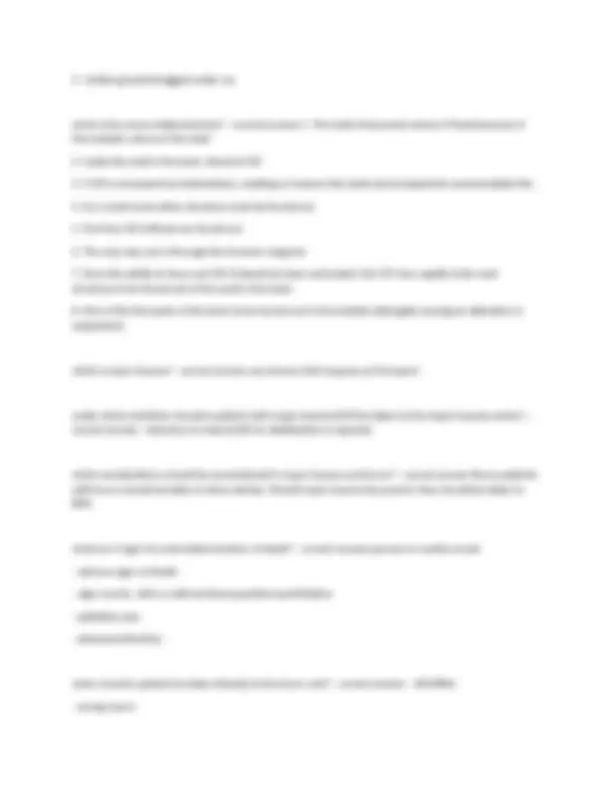
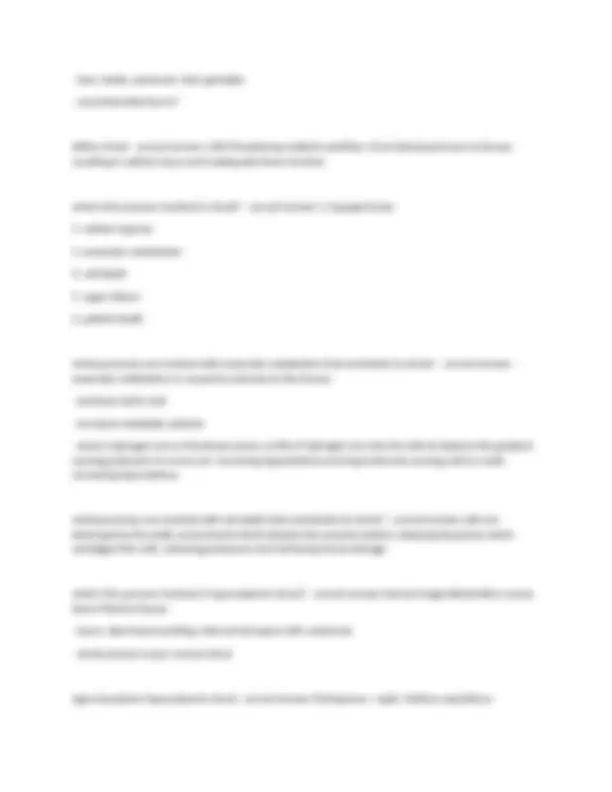

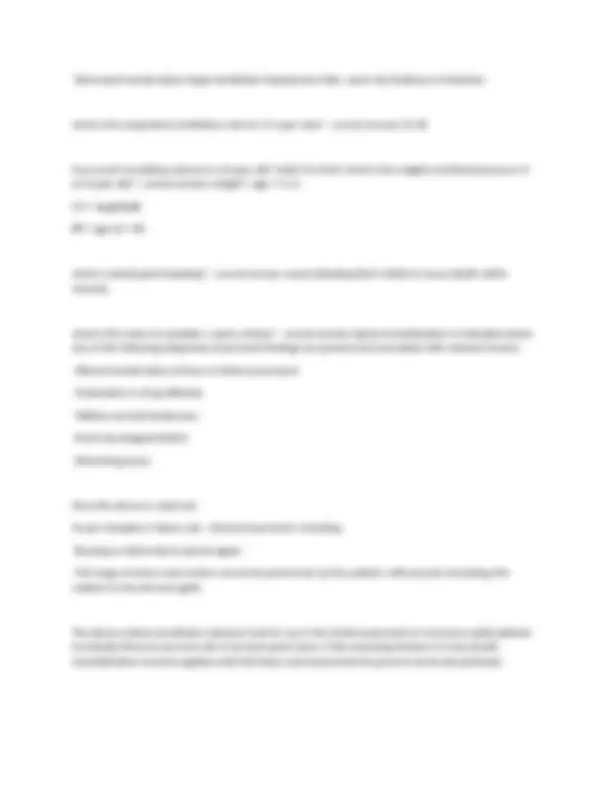
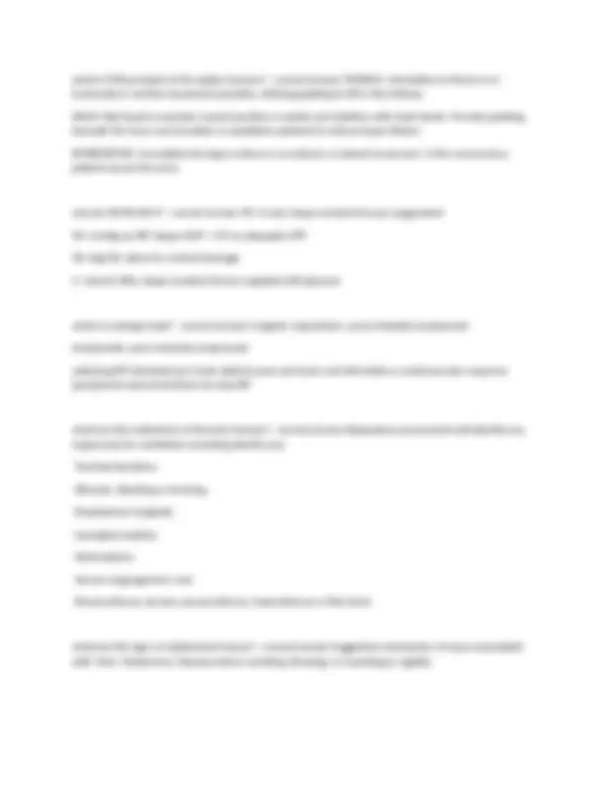
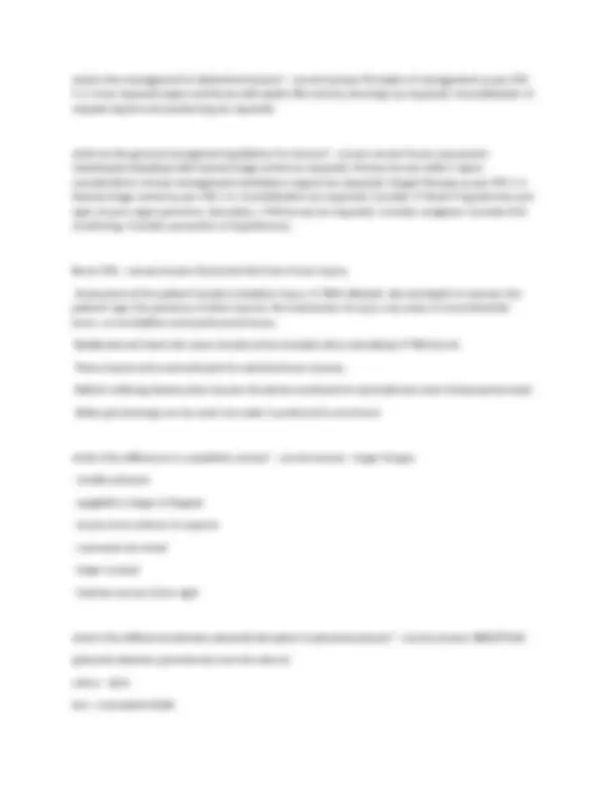


Study with the several resources on Docsity

Earn points by helping other students or get them with a premium plan


Prepare for your exams
Study with the several resources on Docsity

Earn points to download
Earn points by helping other students or get them with a premium plan
Community
Ask the community for help and clear up your study doubts
Discover the best universities in your country according to Docsity users
Free resources
Download our free guides on studying techniques, anxiety management strategies, and thesis advice from Docsity tutors
PHTLS & exam prep with complete solution passed 2023.docx
Typology: Exams
1 / 12

This page cannot be seen from the preview
Don't miss anything!







what are newton's 1st & second laws? - correct answer 1: a body at rest will remain at rest, and a body in motion will remain in motion until acted upon by an outside force 2: force = mass x accelleration what are the rule of 9's? - correct answer ADULT 9% = entire head 9% = entire arm 9% =chest 9% =abdomen 18% = entire back 18% = entire leg 1% perineum CHILD 18% = entire head 9% =entire arm 9% = chest 9% = abdomen 18% = entire back 14% = entire leg 1% = perineum
what are the signs/symptoms of spinal injury? - correct answer neurologic function above the injury is intact and function below the injury is absent or markedly diminished. Specific manifestations will depend on the exact level of injury. what are the (5) major areas of blood loss? - correct answer - external
Cardiovascular response (pulse or blood pressure) to changes in posture Symptomatic hypotension Tachycardia - rapid, weak, thready pulse Decreased mental status - anxiety/restlessness
Hives or welts (weal-like swellings). Tingling mouth. Abdominal pain, vomiting (these are signs of severe allergic reaction to insects). Anaphylaxis: Difficult/noisy breathing. Swelling of tongue. Swelling/tightness in throat. Difficulty talking and/or hoarse voice. Wheeze or persistent cough. Persistent dizziness and/or collapse. Pale and floppy (young children). what is the process involved in septic shock? - correct answer Septic shock is most often the result of a severe bacterial infection. Most cases of septic shock are caused by hospital-acquired gram-negative bacilli or gram-positive cocci and often occur in immuno-compromised patients and those with chronic and debilitating diseases. Rarely, it is caused by Candida or other fungi. A unique form of shock caused by staphylococcal and streptococcal toxins is called toxic shock. Septic shock occurs more often in neonates, patients > 35 yr, and pregnant women. Predisposing factors include diabetes mellitus; cirrhosis; leukopaenia, especially that associated with cancer or treatment with cytotoxic drugs; invasive devices, including endotracheal tubes, vascular or urinary catheters, drainage tubes, and other foreign materials; and prior treatment with antibiotics or corticosteroids. Common causative sites of infection include the lungs and the urinary, biliary, and GI tracts. The pathophysiology of septic shock is not entirely understood, but it is known that a key role in the development of severe sepsis is played by an immune and coagulation response to an infection. Both pro-inflammatory and anti-inflammatory responses play a role in septic shock signs/symptoms septic shock - correct answer Similar to hypovolaemic shock except in the first stages: Pyrexia Systemic vasodilation resulting in hypotension Warm and sweaty skin CPG says:
Decreased mental status Hyperventilation Hypotension Skin; warm dry Evidence of infection what is the respiration/ventilation rate for 2-5 year olds? - correct answer 25- how much circulating volume in a 8 year old? what % is that? what is the weight and blood pressure of an 8 year old? - correct answer weight = age + 4 x 2 CV = weightx BP = age x2 + 80 what is catastrophic bleeding? - correct answer severe bleeding that is likely to cause death within minutes what is the nexus & canadian c-spine criteria? - correct answer Spinal immobilisation is indicated where any of the following (stepwise) assessment findings are present and associated with relevant trauma: Altered mental status at time of initial assessment; Intoxication or drug affected; Midline cervical tenderness; Focal neurological deficit; Distracting injury Once the above is ruled out: As per Canadian C-Spine rule - Clinical assessment, including: Bruising or deformity to spinal region; Full range of active neck motion cannot be performed, by the patient, without pain (including 45o rotation to the left and right). The above criteria constitute a decision tool for use in the initial assessment of conscious adult patients to indicate those at very low risk of cervical spine injury. If the assessing clinician is in any doubt, immobilisation must be applied until full history and assessment be prove it can be discontinued.
what is the management of abdominal trauma? - correct answer Principles of management as per CPG 5.1; Cover exposed organs and tissue with plastic film and dry dressings (as required); Immobilisation of impaled objects and positioning (as required). what are the general management guidelines for trauma? - correct answer Scene assessment; Catastrophic bleeding (with haemorrhage control as required); Primary Survey (with C-Spine consideration); Airway management/ventilatory support (as required); Oxygen therapy as per CPG 1.5; Haemorrhage control as per CPG 5.4; Immobilisation (as required); Consider IV fluids if hypotensive and signs of poor organ perfusion; Secondary / CNS Survey (as required); Consider analgesia; Consider ECG monitoring; Consider prevention of hypothermia. Burns CPG - correct answer Document the time of burn injury; Assessment of the patient includes inhalation injury; % TBSA affected; site and depth of wounds; the patient's age; the presence of other injuries, the mechanism of injury; any areas of circumferential burns, co-morbidities and psychosocial issues; Reddened and intact skin areas should not be included when calculating % TBSA burnt; There may be entry and exit point for electrical burn injuries; Patient suffering electrocution injuries should be monitored for dysrhythmias (and 12-lead performed); Water gel dressings can be used, but water is preferred to cool burns. what is the difference in a paediatric airway? - correct answer - larger tongue
uterus - increased tone pain - tender to touch level of shock - may not be proportionate to visible blood loss clotting - may not see clots presenting part - engaged